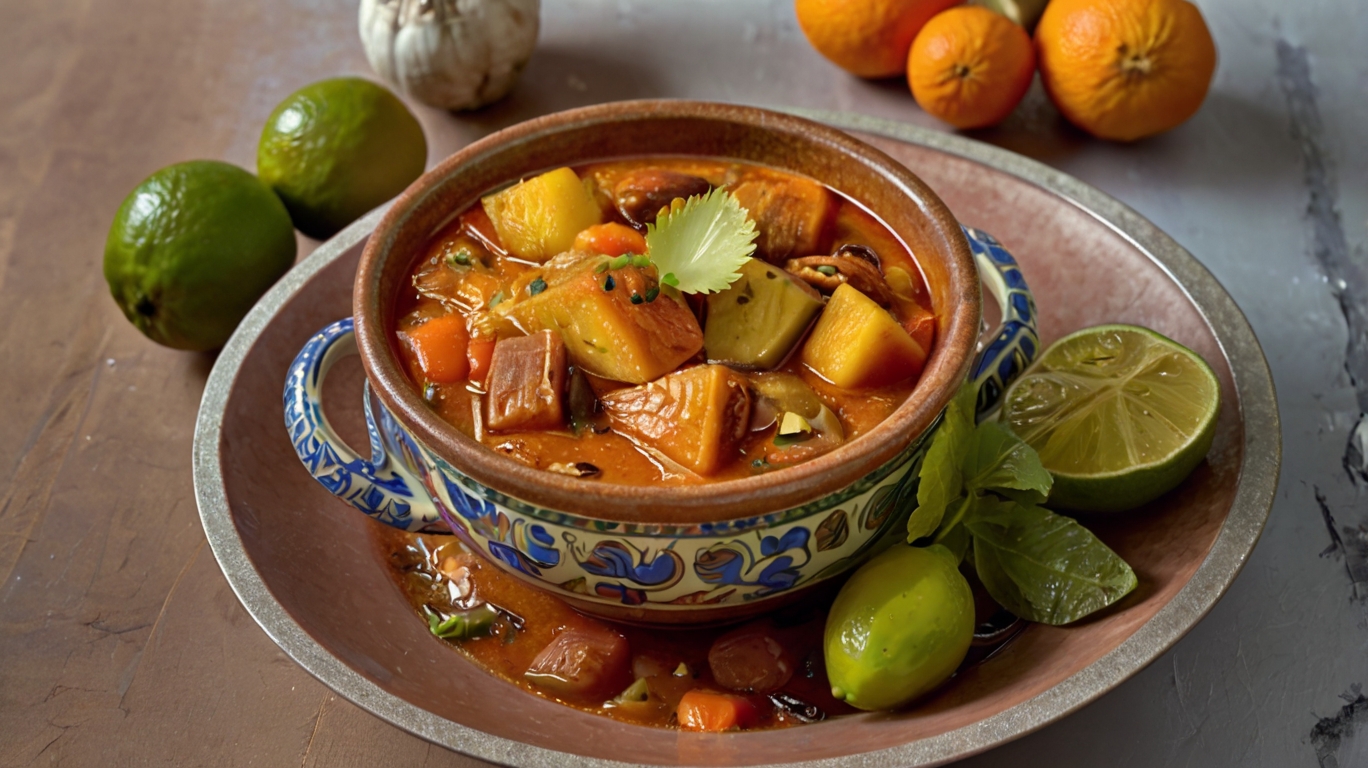If you’re looking to try a unique and traditional Puerto Rican dish, the Puerto Rican Cuajito Recipe is a must.
This dish, made from pig’s intestines, might sound unusual to some, but it’s a beloved delicacy in Puerto Rico.
It’s one of those recipes that’s passed down through generations, bringing families together for special occasions or casual weekend meals.
The preparation of cuajito takes some time and patience, but the result is worth it.
The dish is flavorful, hearty, and carries the essence of Puerto Rican cuisine, which is rich in history and culture.
It’s perfect for anyone who wants to explore authentic Puerto Rican flavors and enjoy a meal that’s truly special.
I was introduced to this dish during one of my travels, and since then, it has held a special place in my heart. The flavors are bold and the texture unique.
In this post, I’ll take you through everything you need to know about Puerto Rican Cuajito, from what it is to how to make it, along with a few tips and tricks to perfect it at home.
What is the Puerto Rican Cuajito Recipe?
Puerto Rican Cuajito is a traditional dish made from pig intestines, which are cleaned, seasoned, and slow-cooked until tender.
While it may sound unusual to some, in Puerto Rican cuisine, using every part of the animal is common, and dishes like cuajito are cherished for their taste and significance.
Cuajito is usually stewed with a mix of spices and herbs to enhance the flavor, creating a savory dish that pairs well with rice or plantains.
It’s often served during festive occasions or as a hearty weekend meal, and it’s a dish that brings people together.
Preparing cuajito takes some time, as the intestines need to be properly cleaned and cooked slowly to achieve the right texture.
How Puerto Rican Cuajito Recipe Tastes Like?
Puerto Rican Cuajito has a distinct taste that’s savory, slightly tangy, and full of rich, meaty flavor.
The intestines absorb the flavors of the spices, herbs, and broth they’re cooked in, making the dish flavorful and aromatic.
The texture of cuajito can be a bit chewy, which adds to its unique appeal. When cooked properly, the intestines become tender, soaking up all the wonderful flavors of the stew.
The combination of the spices and the meat creates a bold taste that’s comforting and hearty, perfect for those who enjoy traditional, robust dishes.
When Was I First Introduced to Shrimp Cargot?
I first learned about cuajito during one of my culinary adventures while traveling. However, it wasn’t until I heard about Shrimp Cargot that my interest in unique dishes truly blossomed.
Shrimp Cargot is a savory dish that opened my eyes to exploring more traditional and regional foods. From that moment, I sought out other distinctive dishes, which is how I stumbled upon Puerto Rican Cuajito.
The cultural connection and the use of ingredients that may seem uncommon made cuajito an unforgettable experience for me.
Equipment
- Large Pot or Dutch Oven
- Sharp Knife
- Cutting Board
- Colander
- Large Bowl
- Slotted Spoon
- Tongs
- Wooden Spoon or Spatula
- Measuring Spoons
- Mixing Bowl (for soaking)
Ingredients to Make Puerto Rican Cuajito Recipe
- Pig Intestines = 02 pounds (cuajito)
- Vinegar = 02 tablespoons (for cleaning)
- Salt = 01 tablespoon (for cleaning)
- Garlic = 03 cloves (minced)
- Onion = large (chopped)
- Green Bell Pepper = 01 (chopped)
- Red Bell Pepper = 01 (chopped)
- Tomatoes = 02 (diced)
- Leaves = 02 bay
- Oregano = 02 teaspoons (dried)
- Cumin = 01 teaspoon
- Adobo Seasoning = 01 teaspoon
- Chicken Broth or Water = 02 cups
- Olive Oil = 02 tablespoons
- Sofrito = 1/4 cup (for extra flavor) (Optional)
- Salt and Pepper to taste
How to Make Puerto Rican Cuajito
Step by Step Instructions:
Step 01: Clean the Intestines
- Rinse the pig intestines in cold water.
- Soak them in water with vinegar and salt for 30 minutes.
- Rinse again after soaking, and set the intestines aside.
Step 02: Prepare the Vegetables
- Chop the onion, bell peppers, and tomatoes.
- Mince the garlic and keep all vegetables ready.
Step 03: Cook the Intestines
- Heat olive oil in a pot over medium heat.
- Add minced garlic, onions, and bell peppers. Cook for 5-7 minutes.
- Add the intestines and cook until lightly browned, about 5 minutes.
Step 04: Add Seasonings
- Stir in tomatoes, bay leaves, oregano, cumin, and adobo seasoning.
- Add sofrito if you want more flavor.
Step 05: Add Broth and Simmer
- Pour the broth or water to cover the intestines.
- Bring to a boil, then lower the heat to simmer.
- Cook for 2-3 hours, stirring occasionally, until tender.
Step 06: Season to Taste
- Once tender, taste the dish and adjust seasoning.
- Add salt and pepper if needed.
Step 07: Serve
- Use tongs to serve the cuajito.
- Serve it hot with rice or tostones.
Servings and Preparation Times
- Preparation Time: 30 minutes
- Cook Time: 2-3 hours
- Total Time: Approximately 3-3.5 hours
- Servings: This recipe serves 4-6 people depending on portion sizes. It’s a filling dish, so even a small serving goes a long way.
Nutrition Information
| Nutrient | Amount Per Servings) |
| Calories | 320 kcal |
| Protein | 25 g |
| Carbohydrates | 10 g |
| Fat | 20 g |
| Fibre | 2 g |
| Sodium | 800 mg |
| Cholesterol | 80 mg |
| Sugars | 3 g |
Recipe Tips
- Clean the Intestines Thoroughly: Cleaning the intestines is the most important step. Rinse them well, then soak them in water with vinegar and salt to remove any impurities. Be sure to rinse them again after soaking.
- Cook on Low Heat: Slow cooking is key for this recipe. The intestines need time to become tender and absorb the flavors of the broth and spices. Patience will pay off when you get that perfect texture.
- Season Generously: Don’t be shy with the spices. Garlic, oregano, and bay leaves are great choices to give the dish a flavorful base. Puerto Rican cuisine often uses adobo and sofrito, so feel free to add those for extra taste.
- Serve with Traditional Sides: Cuajito pairs wonderfully with white rice, tostones (fried plantains), or even a side of beans. These sides help balance out the rich flavors of the dish.
- Add Vegetables: You can include vegetables like onions, peppers, and tomatoes in the stew to add more flavor and texture. They blend well with the cuajito and make the dish more hearty.
FAQs
Is cuajito safe to eat?
Yes, as long as the intestines are cleaned properly and cooked thoroughly, cuajito is safe to eat. The key is to take your time with the cleaning process.
Can I use other spices in the recipe?
Absolutely! You can adjust the seasoning to your taste. Traditional Puerto Rican spices like adobo, sofrito, and cumin work great, but feel free to experiment with other flavors.
How long does it take to cook cuajito?
It usually takes around 2-3 hours to cook cuajito until tender. The slow cooking process helps ensure the intestines are soft and flavorful.
Can I make cuajito in a pressure cooker?
Yes, a pressure cooker can help speed up the cooking process. It can reduce the cooking time by half, but make sure the intestines are still properly cleaned and prepped.
Can I freeze leftover cuajito?
Yes, cuajito can be stored in an airtight container in the freezer for up to 3 months. Just be sure to reheat it thoroughly before serving.
What to Serve with Puerto Rican Cuajito Recipe
Cuajito is a rich and hearty dish, so it’s best served with sides that balance out its bold flavors. Some traditional options include:
- White Rice: Rice is a staple side dish in Puerto Rican cuisine, and it complements cuajito perfectly by soaking up the flavorful sauce.
- Tostones: These fried green plantains add a crispy texture that contrasts nicely with the soft and tender cuajito.
- Maduros (Sweet Plantains): If you prefer something sweeter, maduros make a great side. Their sweetness balances the savory flavors of the cuajito.
- Beans: A side of stewed beans, seasoned with sofrito and spices, adds another layer of flavor and makes the meal more filling.
- Avocado Salad: A light and fresh avocado salad can help balance out the richness of the dish, offering a refreshing bite with each spoonful.
- Pique (Puerto Rican Hot Sauce): If you like a little heat, drizzle some Puerto Rican pique over the cuajito for an extra kick of flavor.
Storage Tips
- Refrigerate Leftovers: Store any leftover cuajito in an airtight container. Place it in the refrigerator, where it will stay fresh for up to 3 days.
- Freeze for Later: If you want to keep it longer, freeze the cuajito. Use a freezer-safe container or bag, and it will last for up to 2 months.
- Reheat Gently: When reheating, warm it on the stove over low heat to avoid overcooking. You can add a little broth or water if it thickens too much.
- Avoid Microwave: For best texture and flavor, it’s better to reheat cuajito on the stovetop instead of the microwave.
Concluding Remarks
Puerto Rican Cuajito is not just a dish; it’s a tradition that brings people together.
While it may take some time to prepare, the result is a flavorful, comforting meal that represents the heart of Puerto Rican cuisine.
Whether you’re trying it for the first time or it’s already a family favorite, this cuajito recipe is sure to bring a taste of Puerto Rico to your table.
So take your time, follow the steps, and enjoy the unique flavors of this beloved dish.
Enjoy your Cooking Adventure with Munchiie!
More Amazing Recipies
- Penn Station Cookie Recipe
- Howard Johnson Chicken Croquettes Recipe
- Zaxby’s Wimpy Sauce Recipe
- Wawa Chicken Salad Recipe

Puerto Rican Cuajito Recipe
Ingredients
Equipment
Method
- Step by Step Instructions:
- Rinse the pig intestines in cold water.
- Soak them in water with vinegar and salt for 30 minutes.
- Rinse again after soaking, and set the intestines aside.
- Chop the onion, bell peppers, and tomatoes.
- Mince the garlic and keep all vegetables ready.
- Heat olive oil in a pot over medium heat.
- Add minced garlic, onions, and bell peppers. Cook for 5-7 minutes.
- Add the intestines and cook until lightly browned, about 5 minutes.
- Stir in tomatoes, bay leaves, oregano, cumin, and adobo seasoning.
- Add sofrito if you want more flavor.
- Pour the broth or water to cover the intestines.
- Bring to a boil, then lower the heat to simmer.
- Cook for 2-3 hours, stirring occasionally, until tender.
- Once tender, taste the dish and adjust seasoning.
- Add salt and pepper if needed.
- Use tongs to serve the cuajito.
- Serve it hot with rice or tostones.
- Preparation Time: 30 minutes
- Cooking Time: 2-3 hours
- Total Time: Approximately 3-3.5 hours
- Serves: This recipe serves 4-6 people depending on portion sizes. It’s a filling dish, so even a small serving goes a long way.
Notes
- Clean the Intestines Thoroughly: Cleaning the intestines is the most important step. Rinse them well, then soak them in water with vinegar and salt to remove any impurities. Be sure to rinse them again after soaking.
- Cook on Low Heat: Slow cooking is key for this recipe. The intestines need time to become tender and absorb the flavors of the broth and spices. Patience will pay off when you get that perfect texture.
- Season Generously: Don’t be shy with the spices. Garlic, oregano, and bay leaves are great choices to give the dish a flavorful base. Puerto Rican cuisine often uses adobo and sofrito, so feel free to add those for extra taste.
- Serve with Traditional Sides: Cuajito pairs wonderfully with white rice, tostones (fried plantains), or even a side of beans. These sides help balance out the rich flavors of the dish.
- Add Vegetables: You can include vegetables like onions, peppers, and tomatoes in the stew to add more flavor and texture. They blend well with the cuajito and make the dish more hearty.











Leave a Reply